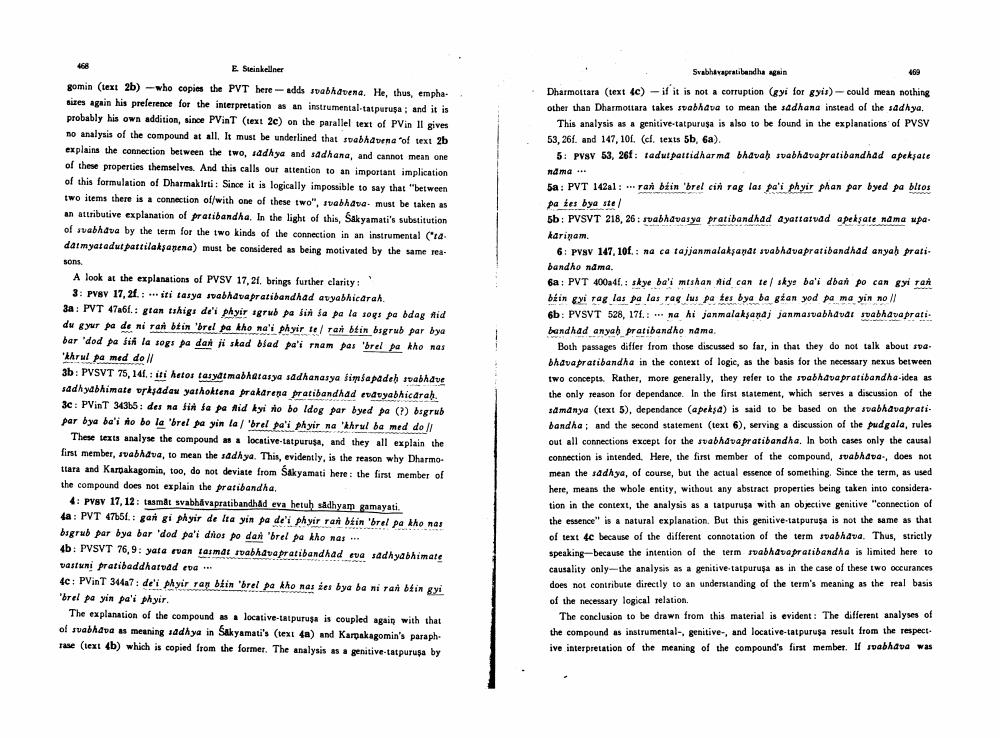Book Title: Svabhavarat Bandha Again Author(s): Ernat Steinkellner Publisher: Ernat Steinkellner View full book textPage 7
________________ E Steinkellner gomin (text 2b)-who copies the PVT here - adds rabhauena. He, thus, emphasises again his preference for the interpretation as an instrumental taperusa; and it is probably his own addition, since PVinT (text 2e) on the parallel text of PVin Il gives no analysis of the compound at all. It must be underlined that rahduena of text 2b explain the connection between the two, Idd Aya and sadhana, and cannot mean one of these properties themselves. And this calls our attention to an important implication of this formulation of Dharmakiri: Since it is logically impossible to say that "between two items there is a connection of/with one of these two", rabhas must be taken as an attributive explanation of pratibandha. In the light of this, Stkyamati's substitution of vabhava by the term for the two kinds of the connection in an instrumental (ta. datmyatadut parrilaksana) must be considered as being motivated by the same te sons. A look at the explanations of PVSV 17,21. brings further clarity: 3. PVBY 17, 2f.: iti tasya sabhava pratiband had avyabhicara 30 : PVT 47a6f.: gran tskigt di'i phyir igru pa din sa pa la sops po bdag Mid du gyur pa de ni rant btin 'bral pa kho na'i phyir terar din begreb par bya bar 'dod pa si la sog: pa dant i skad blad pa'i ruam pas 'brel pa tho nas khrul pa med doll 3b: PVSVT 75,141.: ili hatos tasyai mabadtasya sadhanaiya lima padeh sabhave iddiyabhimate urajadaw yatholtena prakarana pratibandhad rudoyab Nicarab. 3c: PVinT 34315: des na si fa pe Aid kyi no bo ldog pur dyed pa (?) bigrub par bya ba'i no bo la 'brel pa yin la/ 'brel pal payir na "hrul ba med doll These texts analyse the compound a locative-latpuruse, and they all explain the lini member, svabhava, to mean the addhya. This, evidently, is the reason why Dharmo tiara and Karpakagomin, too, do not deviate from Sakyamati here: the first member of the compound does not explain the pratibandha. 4: Pvsy 17,12: tasmát svabhavapratibandhad eva hetuh sdhyamamayati. 4a: PVT (751.: gan gi payir de Itayin pa de'i phyir rai bin 'bral pa Aho nas bagrub par bya bar 'dod pa'i dilos po dal 'brel pa kho nas 4b. PVSVT 76,9: yata ruan farmde rabhasa pratibandhad evo sadhyabhimate Dostui pratibeddharudd .. 4c: PVinT 3467: de'i phyir rar blin 'brel pa kho nas iu bya ba ni rantingyi 'bral pe yin pa'i phyir. The explanation of the compound locative-latpurusa is coupled again with that of mathavaas meaning addhya in Saikyamati's (text 4) and Karpakagomin's paraph Tame (text (b) which is copied from the former. The analysis as genitive-latpurusa by Svabhavaratibandha again Dharmottara (text (c)- if it is not a corruption (gyi for gyis) - could mean nothing other than Dharmottara takes svabhava to mean the sadhana instead of the sad Ayo This analysis as a genitive-tatpurusa is also to be found in the explanations of PVSV 53, 26. and 147, 101. (cl. texts Sb, 6a). 5: Pay 53, 261: tadu pairidharma bhavah svabhava pratibandhad apekate ndma... Sa: PVT 142a1: ran bein 'brel cixi rag les pa'i phyar phan par byed pa blios pa tes by ste sb: PVSVT 218, 26: sabhavasya pratibandhad dyartarudd apekate nama wa kariņam. 6: PVSV 147, 10f.: na ca tajjanmalaksapat svabhava pratiband had anyab prati bandho nama. 6a: PVT 400941, skye ba'mishan Hid can te skye ba'i dba po can kyi Tak béin gyi rag las pa las rag lus pa tes bya ba gian god pa ma yin noll 6b: PVSVT 528, 171, no hi janmalaksandi janmasvabhdudi sabhava prati. bandhad anyab pratibandho nama Both passages differ from those discussed so far, in that they do not talk about sa bhava pratibandha in the context of logic, as the basis for the necessary nexus between two concepts. Rather, more generally, they refer to the seabhavapraribandha-idea as the only reason for dependance. In the first statement, which serves a discussion of the sd mdnya (text 5), dependance (apeksa) is said to be based on the sabhava prati bandha; and the second statement (text 6), serving a discussion of the pudgala, rules out all connections except for the sabhava pratibandha. In both cases only the causal connection is intended. Here, the first member of the compound, svabhava, does not mean the sadAyo, of coure, but the actual essence of something. Since the term, as used here, means the whole entity, without any abstract properties being taken into considera tion in the context, the analysis as a tatpurusa with an objective genitive connection of the essence" is a natural explanation. But this genitive-tatpurusa is not the same as that of text 4c because of the different connotation of the term Jabhasa. Thus, strictly speaking because the intention of the term rabhasa pratibandha is limited here to causality only the analysis as a genitive-tatpurusa as in the case of these two oscurances does not contribute directly to an understanding of the term's meaning as the real basis of the necessary logical relation The conclusion to be drawn from this material is evident: The different analyses of the compound as instrumental, genitive, and locative-tatpurusa result from the respect ive interpretation of the meaning of the compound's first member. If sabhava wasPage Navigation
1 ... 5 6 7 8 9 10 11
